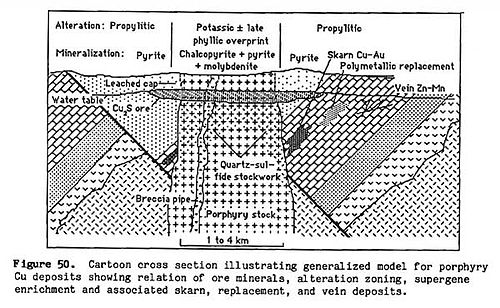- Porphyry copper deposit
-
Porphyry copper deposits are copper orebodies which are associated with porphyritic intrusive rocks and the fluids that accompany them during the transition and cooling from magma to rock. Circulating surface water or underground fluids may interact with the plutonic fluids. Successive envelopes of hydrothermal alteration typically enclose a core of ore minerals disseminated in often stockwork-forming hairline fractures and veins. Porphyry orebodies typically contain between 0.4 and 1 % copper with smaller amounts of other metals such as molybdenum, silver and gold.
The first mining of low-grade copper porphyry deposits from large open pits coincided roughly with the introduction of steam shovels, the construction of railroads, and a surge in market demand near the start of the 20th century. Some mines exploit porphyry deposits that contain sufficient gold or molybdenum, but little or no copper.
Porphyry copper deposits are currently the largest source of copper ore. Most of the known porphyrys are concentrated in: western South and North America and Southeast Asia and Oceana - along the Pacific Ring of Fire; the Caribbean; southern central Europe and the area around eastern Turkey; scattered areas in China, the Mideast, Russia, and the CIS states; and eastern Australia.[1][2] Only a few are identified in Africa, in Namibia[3] and Zambia;[4] none are known in Antarctica. The greatest concentration of the largest copper porphyrys is in Chile. Almost all mines exploiting large porphyry deposits produce from open pits.
Contents
Characteristics
Characteristics of porphyry copper deposits include:
- The orebodies are associated with multiple intrusions and dikes of diorite to quartz monzonite composition with porphyritic textures.
- Breccia zones with angular or locally rounded fragments are commonly associated with the intrusives. The sulfide mineralization typically occurs between or within fragments.
- The deposits typically have an outer epidote - chlorite mineral alteration zone.
- A quartz - sericite alteration zone typically occurs closer to the center and may overprint.
- A central potassic zone of secondary biotite and orthoclase alteration is commonly associated with most of the ore.
- Fractures are often filled or coated by sulfides, or by quartz veins with sulfides. Closely spaced fractures of several orientations are usually associated with the highest grade ore.
- The upper portions of porphyry copper deposits may be subjected to supergene enrichment. This involves the metals in the upper portion being dissolved and carried down to below the water table, where they precipitate.
Porphyry copper deposits are typically mined by open-pit methods.
Examples of porphyry copper deposits
- La Caridad, Sonora, Mexico
- Dizon, Philippines[5]
Chile
- Cerro Colorado[5]
- Chuquicamata
- Collahuasi[5]
- Escondida
- El Abra[5]
- El Salvador[5]
- El Teniente
- Los Pelambres[5]
- Radomiro Tomić
Panama
- Coclesito[6]
Serbia
- Majdanpek[5]
Peru
- Toquepala
- Cerro Verde, southeast of the city of Arequipa
United States
- Ajo, Arizona
- Bagdad, Arizona
- Lavender Pit, Bisbee, Arizona
- Morenci, Arizona
- Pebble Mine, Alaska
- Safford Mine, Safford, Arizona
- San Manuel, Arizona
- Sierrita, Arizona[7]
- Resolution Copper, Superior, Arizona
- El Chino, Santa Rita, New Mexico
- Ely, Nevada
- Bingham Canyon Mine, Utah
- Ray Mine, Arizona[8]
Australia
- Cadia-Ridgeway Mine, New South Wales, copper-gold deposit mined by open pit and block caving.
- Northparkes copper porphyry deposit, New South Wales, with 63 million tonnes at 1.1% Cu and 0.5 ppm Au.
- Boddington, Western Australia, one of the largest Archaean gold porphyry deposits in Australia
Indonesia
- Grasberg mine, at >3 billion tonnes at 1 ppm Au, is one of the world's largest and richest porphyry deposits of any type
Papua New Guinea
Mongolia
- Oyuu Tolgoi is one of the world's largest and richest Cu porphyry desposits
Porphyry-type ore deposits for metals other than copper
Copper is not the only metal that occurs in porphyry deposits. There are also porphyry ore deposits mined primarily for molybdenum, many of which contain very little copper. Examples of porphyry molybdenum deposits are the Climax, Urad, and Henderson deposits in central Colorado, and the Questa deposit in northern New Mexico.
The US Geological Survey has classed the Chorolque and Catavi tin deposits in Bolivia as porphyry tin deposits.[9]
Some porphyry copper deposits in oceanic crust environments, such as those in the Philippines, Indonesia, and Papua New Guinea, are sufficiently rich in gold that they are called copper-gold porphyry deposits.[10]
References
- ^ http://geopubs.wr.usgs.gov/open-file/of02-268/maps/map1.pdf
- ^ http://www.mme.gov.na/gsn/basemetals.htm#Haib
- ^ http://www.mme.gov.na/gsn/basemetals.htm
- ^ http://www.mawsonwest.com.au/multimedia/1/ASX%20Chimpantika%20160407.pdf
- ^ a b c d e f g Sillitoe, Richard H., Porphyry Copper Systems, 2010, Economic Geology, v. 105, pp. 3-41
- ^ Cobre Panama, Inmet Mining
- ^ West, Richard J. and Daniel M. Aiken, Geology of the Sierrita-Esperanza Deposit, Chapter 21 in Advances in the Geology of the Porphyry Copper Deposits, The University of Arizona Press, 1982, ISBN 0-8165-0730-9
- ^ Banks, Norman G., Sulfur and Copper in Magma and Rocks: Ray Porphyry Copper Deposit, Pinal County, Arizona, Chapter 10 in Advances in the Geology of the Porphyry Copper Deposits, The University of Arizona Press, 1982, ISBN 0-8165-0730-9
- ^ Bruce L. Reed (1986) Descriptive model of porphyry Sn, in Mineral Deposit Models, US Geological Survey Bulletin 1693, p.108.
- ^ R. L. Andrew (1995) Porphyry copper-gold deposits of the southwest Pacific, Mining Engineering, 1/1995, p.33-38.
- Dennis P. Cox, 1986, "Descriptive model of porphyry Cu," in Mineral Deposit Models, US Geological Survey, Bulletin 1693, p. 76, 79.
Ores Acanthite (silver) · Chalcopyrite (copper) · Chalcocite (copper) · Cinnabar (mercury) · Galena (lead) · Pentlandite (nickel) · Sphalerite (zinc)OtherOre deposit types Banded iron formation · Carbonate hosted lead zinc ore deposits · Heavy mineral sands · Iron oxide copper gold · Kambalda type komatiitic nickel ore deposits · Lateritic nickel · Magmatic nickel-copper-iron-PGE deposits · Porphyry copper · Sedimentary exhalative deposits · Volcanogenic massive sulfideCategories:
Wikimedia Foundation. 2010.

